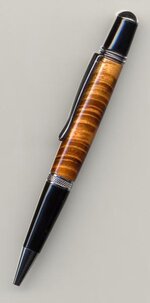Gary Beasley
Member
The friendly owner of CAG lumber gave me a scrap of jobillo board they couldn't use due to a crack running up it. I took it home and cut a pile of cross grain blanks, knowing full well this was not going to be a walk in the park. Well the first three times the piece would get close to size and catch and shatter. I'd about lost my patience with it. Today I was feeling good about it so I tried it again. After setting up the blank and starting in to round it using my skew to shear cut it I was still getting splinters flying off. When I had a chip take off enough to show some tube I glued it back on and thought about it a bit. Then a revelation hit me, I was turning end grain, so I needed to flip the handle up and do a scrape cut. I tried it and was amazed at how well the cutting went after that. If you look near the clip you can see the chip I tried to hide, you could still see some brass there.
Attachments
Last edited:

